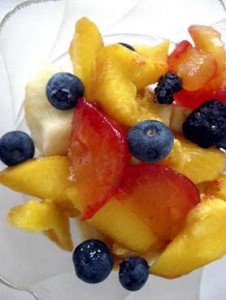
More evidence that low-calorie sweeteners are bad for your health
Studies show that artificial sweeteners can raise the risk of hypertension, metabolic syndrome, type 2 diabetes and heart disease, including stroke.

Natural Health News — Eating more whole fruits, particularly blueberries, grapes and apples, is associated with a lower risk of type-2 diabetes.
But say scientists in the British Medical Journal, greater fruit juice consumption has an adverse effect.
Increasing fruit consumption has been recommended for the prevention of many chronic diseases, including type-2 diabetes. However, studies have generated some mixed results.
Researchers from the UK, USA and Singapore therefore looked to examine the association of individual fruit consumption in relation to type-2 diabetes risk three large long-term studies involving more than 187,000 nurses and other health professionals.
The studies included both men and women (151,209 women and 36,173 men) who were healthy and showed no signs of diabetes at the beginning of the studies.
Tracking consumption
The researchers tracked the consumption of ten individual fruits: grapes or raisins; peaches, plums or apricots; prunes; bananas; cantaloupe; apples or pears; oranges; grapefruit; strawberries; blueberries.
The fruit juices studied included apple; orange; grapefruit and other fruit juices.
Questionnaires were used every four years to assess participants’ habitual diet, asking how often, on average, they consumed each food in a standard portion size. Participants could choose from nine possible responses, ranging from “never, or less than once per month” to “six or more times per day”.
Information was also gathered on participants’ body height and weight, cigarette smoking, physical activity, multivitamin use, family history of diabetes and, for women, menopausal status, post-menopausal hormone use and oral contraceptive use.
In all 6.5% of those in the study developed diabetes.
Not so ‘healthy’ juice
Those whose total whole fruit intake was high also tended to live healthier lifestyles, for instance by being more physically activity, taking multivitamins, and eating fewer calories each day. Even so, three servings per week of blueberries; grapes and raisins; apples and pears significantly reduced the risk of type-2 diabetes by 7%.
In contrast, greater consumption of fruit juice was associated with 8% increased risk of developing type-2 diabetes risk.
Substitution of whole fruits for fruit juice was associated with an overall 7% lower risk of developing the disease.
Not all fruits are equal
Some fruits, however, had a more beneficial effect than others. For instance,
Only strawberries and cantaloupe melon showed no real protective effect. The protective effect of blueberries, apples, and red or black grapes could be because of their high levels of antioxidant anthocyanins.
But even after adjusting for the protective effect of this nutrient, the benefits of these whole fruits remained unchanged, suggesting there are other co-factors at work that help reduce the risk of type-2 diabetes. These include substances such as resveratrol in found in grape skins, the chlorogenic acid in peaches, plums, apples and apricots and the naringin in grapefruit.
What the study doesn’t do is define ‘juice’ so we have no way of knowing whether the juice is consumed were, for example, ‘juice drinks’ that contained added sugar or freshly squeezed juices. There is likely to be a big difference in nutritional quality and it would be interesting to see data comparing the health effect of the two.
Say the researchers, their results support recommendations to increase the consumption of a variety of whole fruits as a measure for diabetes prevention.
See also: ‘Healthy’ fruit juice may not be so healthy after all

Please subscribe me to your newsletter mailing list. I have read the
privacy statement